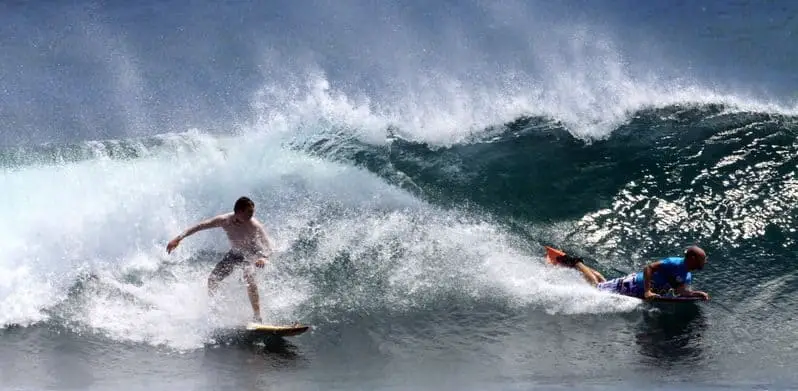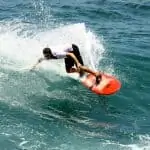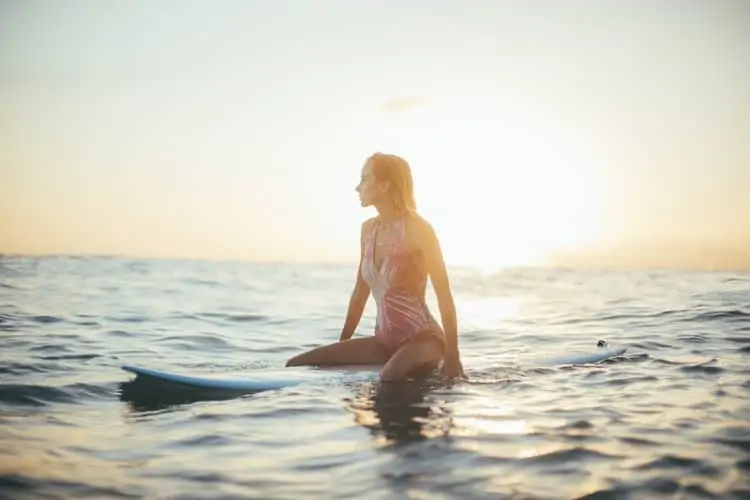What NOT to Do While Surfing: 7 Tips
No doubt you’ve read or seen content online or in print about the many different things to do to improve your surfing.
Tips on how to improve your surf skills by practising and hitting the waves as often as possible are legion.
However, some of the best learning also comes from focusing on how to improve your surfing by not doing certain things out in the waves.
With that in mind, here’s some simple advice to improve your surf skills by avoiding some of the most common pitfalls for learner (and even intermediate!) surfers.
Don’t Paddle Out When it’s Too Big
This is pretty logical, even if you’re excited and the surf has made you pumped up to hit it, to have some fun and to give it a go no matter what.
Paddling into surf that is too big for you in the early stages of your surfing journey can have adverse effects for life.
Firstly, if you get a big scare, then you might be too discouraged to ever surf again, and no one wants that.
Secondly, if you get out and realize that you’re in over your head (literally and figuratively!) you might need help, immediately then putting other people at risk.
Thirdly, you might get in the way of an accomplished surfer on a big wave. The resultant collision could see you suffer injury, as well as the surfer riding the wave.
Remember that when the surf gets big, there’s no shame standing on the beach and watching the ocean – if you want it, another day will come, if not, then enjoy the show from the shore!
Don’t Drop In
This one’s not really that hard to remember. The basic etiquette of dropping in in surfing is as follows:
- If someone is riding a wave, it’s not yours, so don’t paddle for it
- Don’t take off on it, don’t ride it. Leave it alone
- Take your time and the right wave will come for you
Most arguments in the water are over dropping in, and the drop-in rule is the only real reason surfing has some control in the water.
If you paddle out at a heavily localised spot (which you shouldn’t do when learning anyway), dropping in can mean that the locals send you in to the beach, which is not what you want.
Always try to gauge a line-up before paddling out and from the vibe at the beach, especially in the parking lot.

Don’t Get Angry With Kids in the Surf
It sounds a bit trite, but it is actually a thing, especially among frustrated surfers. They are trying their best to improve and are finding it really tough going.
If you’re relatively new to the sport of surfing, you might be having a tough time catching waves or .
Remember that getting angry with a kid is not cool, even if he or she is a bit cheeky and sneaky in the lineup!
Hold back your frustration and try to bite your lip. And besides, you never know how that karma might come back to haunt you in a few years, in the line-up or elsewhere!
Don’t Surf Too Small A Board
It might be cool to buy a Kelly Slater model board or a JJF Model or something equally as smart and fancy as the top surfers are using every day, but with this kind of board you’re going to be sinking, going over the falls and struggling to catch any waves.
Instead, get a soft-top foam surfboard or a mid-length (they’re also pretty on-trend right now) and catch more waves, learn quicker and have more fun.
You’ll also easily be able to sell on a learner surfboard later once you are done with it, so don’t think of as a waste as the right board will help you to progress much more quickly!
Don’t Pull Back (Otherwise, it’s Too Late!)
Suppose you see a wave coming and it looks like it has your name on it.
In that case, you have to make the definitive decision to go for it, to give it your all and catch it: no messing around, no second thoughts, and no hesitating.
So many over-the-falls disasters, flopped take-offs, wipe-outs onto the rocks and general whompings take place because surfers pull back at the critical moment. It might only be for a fraction of a second, but it’s that crucial time that makes all the difference!
It’s a much better decision to go all in and wipe-out than hesitate, pull back and go flying over the falls, tumbling from the top of the wave all the way down, all the while hoping that nobody has caught it on camera!
Don’t Forget You’re in the Wild
Surfing has always been synonymous with sharks, despite the tiny amount of recorded shark attacks for how many people enter the sea each day.
That said, in certain parts of the world, keeping this in mind at all times is essential for your safety.
It might mean the difference between paddling out at a spot an hour later than you’d like, or just passing up on some nice waves because of a shark sighting, but remaining aware of the big predators will instantly keep that much safer.
How could anyone forget the image of World Champion surfer, Mick Fanning, being attacked by a Great White shark during the final of a professional surf event (as shown in the video below).
Fortunately, he was fine, but he did have 2 jet skis and a safety boat all on hand, which normal surfers would not have.
Similarly, think about what’s going on in the water and on the bottom, namely with currents and rocks.
Currents can catch even the most experienced surfers off guard and are not to be taken lightly.
Similarly, be mindful of when you might be surfing over rocks or reef, or just extra shallow water. This can save you a trip to the hospital or even from having a scare but paying attention to your surroundings goes a long way to helping you keep safe and be ready for the next surf instead of watching from shore!
Don’t Panic
It might be obvious, but it is also, simply put, the most important phrase to keep in mind when surfing.
The ocean is ultimately stronger than any person, and panicking only makes your situation twice as bad, never better.
The things that go wrong when you are starting out on a surfing life is often as a result of someone panicking, for instance:
- If you get caught inside by a big wave, don’t panic, because that will use up more oxygen.
- If you lose your board because your leash breaks, don’t panic because if you remain calm, the ocean and waves will usually push you in towards shore.
- If you get caught in a rip, then don’t panic, because you can’t fight against a rip current, and if you relax it will eventually let you free.
Panic is the one thing that can destroy all your good plans and rob you of your strength so quickly.
Instead, if you practise remaining calm, fight your nervous impulses and rise above the anxiety, your surfing life will be a more peaceful, enriching process for it.
Mindful practice has certainly helped me in the surf and even in stressful situations on land, so it could be worth a look for you, too!
Related Question
How long should a beginner surfboard be? Usually, about 2 feet longer than the rider is tall. So, if you’re 5’8, go for a surfboard that’s around 7’8, or even just over 8’0 in length. However, make sure it’s a wide and thick learner surfboard as well for stability.
Remember to check my top recommendations in this dedicated article about the best surfboard brands for learners!




